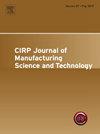A multi-segment two-point receptance coupling method for FRF prediction of holder–tool assemblies
IF 5.4
2区 工程技术
Q2 ENGINEERING, MANUFACTURING
CIRP Journal of Manufacturing Science and Technology
Pub Date : 2025-06-05
DOI:10.1016/j.cirpj.2025.05.006
引用次数: 0
Abstract
This study presents a multi-segment two-point coupling method for predicting the frequency response functions (FRFs) of a holder–tool assembly. The assembly is modeled as a structure consisting of two substructures—an outer tube and an embedded inner cylinder—with a coincident neutral axis, and is then divided axially into multiple segments. For each assembly segment, the FRFs of its substructural components, i.e., the tube and cylinder segments, are theoretically calculated using Timoshenko beam theory. A new receptance coupling principle is established at the two endpoints of each assembly tube and cylinder segment based on their deformation and compatibility conditions. The overall FRFs for each assembly segment are synthesized from the theoretically calculated values of its corresponding tube and cylinder segments. By employing classical receptance coupling substructure analysis (RCSA), the FRFs of the entire assembly are obtained by coupling the individual segment FRFs. Unlike traditional multi-point coupling methods, which generate intermediate matrices strongly dependent on the number of coupling points, the proposed method yields a fixed 4 × 4 intermediate matrix, fully independent of the coupling points. This feature simplifies the calculation procedure to a summation across all segments, eliminating the need for complex iterations required by conventional methods. The proposed method is numerically validated and experimentally verified.
刀柄-工具组合频响预测的多段两点接收耦合方法
提出了一种多段两点耦合预测刀柄-工具组合频响函数的方法。该组件被建模为由两个子结构组成的结构-一个外管和一个嵌入的内圆柱体-具有一致的中性轴,然后在轴向上分为多个部分。对于每个装配节段,其子结构部件,即管和圆柱节段的频响系数采用Timoshenko梁理论进行理论计算。根据各装配管段和筒段的变形和协调条件,建立了新的两端接收耦合原理。每个装配段的总频响是由其相应的管段和圆柱段的理论计算值综合而成的。采用经典的接收耦合子结构分析(RCSA)方法,通过对各个部件的频响进行耦合得到了整个装配的频响。与传统多点耦合方法生成的中间矩阵强烈依赖于耦合点的数量不同,该方法生成的中间矩阵是固定的4 × 4,完全独立于耦合点。该特性将计算过程简化为所有部分的求和,消除了传统方法所需的复杂迭代。该方法得到了数值验证和实验验证。
本文章由计算机程序翻译,如有差异,请以英文原文为准。
求助全文
约1分钟内获得全文
求助全文
来源期刊

CIRP Journal of Manufacturing Science and Technology
Engineering-Industrial and Manufacturing Engineering
CiteScore
9.10
自引率
6.20%
发文量
166
审稿时长
63 days
期刊介绍:
The CIRP Journal of Manufacturing Science and Technology (CIRP-JMST) publishes fundamental papers on manufacturing processes, production equipment and automation, product design, manufacturing systems and production organisations up to the level of the production networks, including all the related technical, human and economic factors. Preference is given to contributions describing research results whose feasibility has been demonstrated either in a laboratory or in the industrial praxis. Case studies and review papers on specific issues in manufacturing science and technology are equally encouraged.
 求助内容:
求助内容: 应助结果提醒方式:
应助结果提醒方式:


